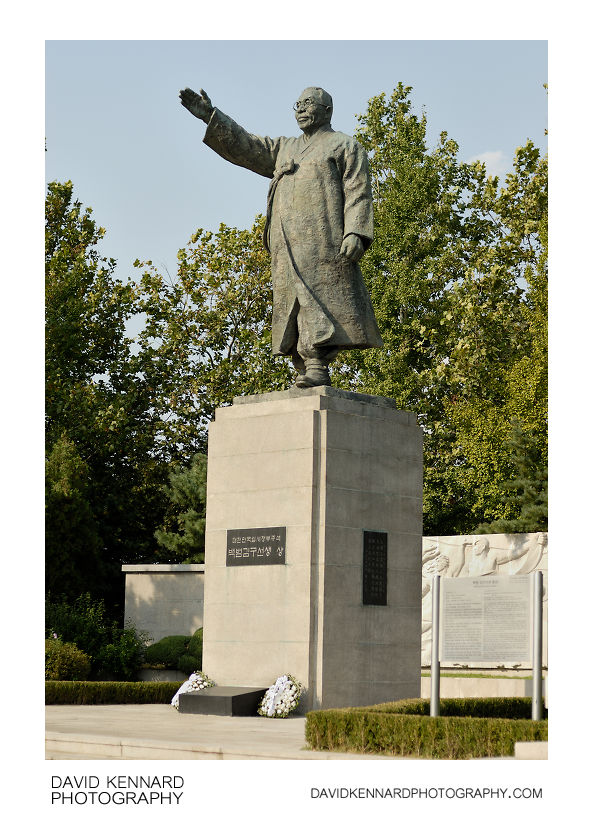Kim Gu Memorial

Description
- Title:
- Kim Gu Memorial
- Caption / Description:
-
The Kim Gu (김구) Memorial Statue in Baekbeom Square (백범광장), Namsan Park (남산공원), Seoul (서울).
Kim Gu campaigned for Korea's independence during the Japanese occupation from 1910 to 1945, and after that, for the reunification of Korea. He was a member of the Provisional Government of the Republic of Korea (대한민국 임시정부) in Shanghai, and became its president in 1927.
After the Japanese occupation ended in 1945, Kim Gu refused to take part in forming a government in South Korea, believing that it would cause North Korea to also form its own government, and possibly cause a civil war. He instead led a group of former independence activists to Pyongyang in North Korea to hold unification talks with Kim Il-sung (김일성), but these talks failed and Kim Gu's fears became reality.
Kim Gu was assasinated in 1949, his murder is thought by many to have been orchestrated by then president Lee Seung Man (이승만) (also known as Syngman Rhee), though there is no evidence to support this theory. Kim was posthumously awarded the Medal of Order of Merit for National Foundation (건국훈장; 建國勳章), the most prestigious civil decoration in the Republic of Korea.
First published in 1947, Kim Gu's autobiography, Journal of Baekbeom (백범일지), is a popular book in South Korea. The book was written under his pen name Baekbeom (백범), which means 'ordinary person', and is considered an important source of information on the Korean Independence Movement.
- Tags / Keywords:
-
- Statue
- Memorial
- Asia
- 한국
- Hanguk
- 韓國
- Jung-gu
- 중구
- 中區
- Korea
- Seoul Special City
- Seoul Teukbyeolsi
- 서울特別市
- 서울특별시
- Hoehyeon-dong
- 회현동
- 會賢洞
- Kim Koo
- Kim Ku
- Kim Gu
- 김구
- 金九
- Baekbeom
- 백범
- 白凡
- Baekbeom Square
- 백범광장
- Namsan Park
- 남산공원
Admin
- Date Original Photo Taken:
- Original File Name:
- _DSC7233a.NEF
- Event:
- Rating:
- ☆
- Date this image added/last updated on website:
- Original File Dimensions:
- 2583px x 3700px
- File Type:
- JPEG
- Color Mode:
- RGB
- Original Image Color Profile:
- Nikon Adobe RGB 4.0.0.3001
Location
- Location Shown:
-
- Sublocation:
- Baekbeom Square
- City:
- Jung-gu
- Province/State:
- Seoul
- Country:
- Korea, Republic Of
- World Region:
- Asia
- Location Created:
-
- Sublocation:
- Baekbeom Square
- City:
- Jung-gu
- Province/State:
- Seoul
- Country:
- Korea, Republic Of
- World Region:
- Asia
- Geo-location:
- 37.554876254528, 126.97990625444 View on map
Rights
- Copyright Status:
- Copyrighted
- Licensing Status:
- Rights Managed
- Available for Editorial Use:
- Yes
- Available for Commercial Use:
- No
- Copyright Notice:
- © 2009 Dave Kennard
Camera Data
- Date Digital Resource was created:
- Shutter speed:
- 1⁄2000 s
- Aperture:
- f/2.5
- Camera Model:
- Nikon D200
- ISO:
- 100
- Exposure Compensation:
- 0
- Focal Length:
- 50mm
- Focal Length (35mm equiv.):
- 75mm
- Metering Mode:
- Multi-segment
- Flash:
- No Flash
- Exposure Mode:
- Auto
- White Balance:
- Manual
- Light Source:
- Cloudy
- Exposure Program:
- Aperture-priority AE
Additional shooting metadata
- Lens:
- Nikon AF Nikkor 50mm F1.4D
- Filters used:
- Additional Optics used:
- Setup:
- Handheld
Post Processing
- Image Modified:
- Software used:
-
- Nikon Capture NX 2
- Post Processing:
-0.23 negative exposure compensation applied in Capture NX 2
Highlight protection slider used in Capture NX 2 to recover lost highlight detail
Color Control Points used in Capture NX 2 to reduce brightness of white flower wreaths
Slight crop in Capture NX 2 to remove bottom of steps
